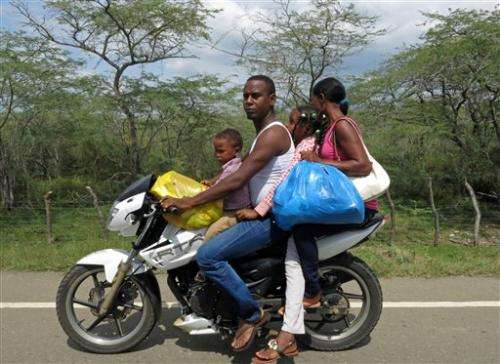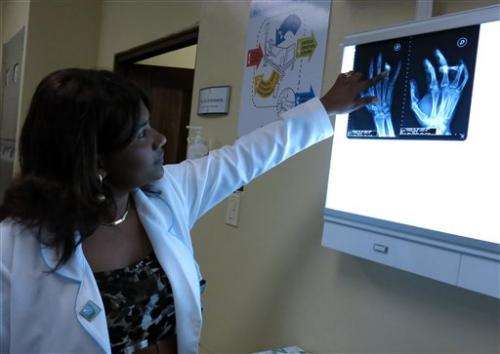Dominican traffic death rate among world's highest

High school student Adonis Tineo lay motionless in an overflowing emergency room on a recent afternoon after slamming his motorcycle into a truck laden with rice as he tried to pass a minivan.
He was driving without a license or a helmet on this Caribbean country's chaotic streets. On top of that, he admitted, he was going the wrong way, against traffic.
"The truck hit me so hard," said Tineo, who started using a motorcycle when he was 12. "They don't stop."
The now-17-year-old was just one of an estimated 25 traffic victims who arrive at the Dario Contreras hospital every day. At another hospital in the capital, doctors treat about 120 accident victims daily, the majority of them motorcycle drivers.
Such accidents, in fact, are shaping up as a major health crisis in this 11 million-person country. The Dominican Republic is effectively the deadliest nation anywhere for drivers, second only to the tiny South Pacific island of Niue, where each death among its roughly 1,400 inhabitants spikes the fatality average. For every 100,000 inhabitants in the Dominican Republic, 42 die every year from traffic accidents, according to the World Health Organization.
It's not unusual in the Dominican Republic to see up to five people, including babies, scrunched atop a motorcycle, or for drivers to carry all types of cargo, including heavy gasoline tanks, atop their bikes. Motorists also dodge hundreds of dilapidated cars and trucks as they zoom across lanes without warning, fail to stop at red lights and go against traffic, often at high speed and sometimes even taking over sidewalks.
The problem is so bad that the U.S. State Department dedicates 10 paragraphs on its travel website to warning visitors about the hazards of driving in the country. U.S. officials recommend that tourists hire a professional driver when visiting, but if that's not an option: "Be aware that the utmost caution and defensive driving are necessary."
Traffic deaths are the top killers of men in the Dominican Republic, with many of the accidents involving motorcycles, said Felix Hernandez, who oversees operations at the Ney Arias Lora trauma center.
"This is one of our biggest epidemics," Hernandez said. "We must strengthen traffic regulations by implementing penalties because that's where it hits people hard."
Dominican officials believe a lethal mix of alcohol, speed and blatant disregard for traffic laws is to blame. On a recent weekend, police stopped more than 460 motorcycles and 170 cars in the capital of Santo Domingo, issuing tickets mostly for driving the wrong way or running red lights.

Many also focus on the growing prevalence of cheap, dangerous motorcycles here. An estimated 1.5 million of them race across the country, representing more than half of all vehicles on the road. The use of motorcycles has grown by an average of 12 percent each year, without taking into account those that aren't registered, according to government statistics.
Motorcycles are also a major danger in Venezuela, the country with the second highest traffic death rate in the Western Hemisphere, with 37 fatalities per 100,000 inhabitants. The United States saw 11 traffic deaths per 100,000 people, while Mexico saw 15, according to the World Health Organization.
Juan Geronimo Brown, director of the Metropolitan Transport Authority in the Dominican Republic, said officials in the capital were trying to rein in the free-for-all fueled by motorcycles.
"We're converting the metropolitan area of Santo Domingo into a chaotic city," Brown said.
Fernando Diaz, a 34-year-old maintenance worker, recently hit another car while driving a motorcycle with his 13-year-old daughter in an impoverished neighborhood in the capital. He was awaiting surgery for his fractured left leg at the Ney Arias Lora center, while his daughter was hospitalized for minor injuries.
"I don't know what happened," he said. "I have no idea where that car came from."
In September, Manuel Segura, a 56-year-old veterinarian, and his daughter, 9-year-old Yamilka, died while coming back from a wake aboard a motorcycle. Segura never used a helmet, and he had turned off his engine to save gas while coasting down a hill toward a minivan, when his brakes failed, said niece Carolina Batista.
Dr. Surelis Jimenez, the Ney Arias Lora hospital's emergencies manager, noted that many accidents claim multiple victims from the same family, and that few people use protective gear.
"You see the majority of motorcycle drivers carrying their helmets on their arm, only to have it accessible if a police officer sees them," she said.
Such accidents cost the country more than $25 million a year in medical expenses, given that the majority of survivors lack health insurance, doctors say. A typical motorcycle injury like a femur fracture, for example, costs nearly $3,000, according to hospital data.
"This is a huge headache for hospital directors like me," Hernandez said. "We are investing our entire budget on treating and helping these men recuperate."
President Danilo Medina has announced plans to boost the number of officers on the road while allowing authorities to crack down on repeat traffic offenders, including revoking their driver's licenses.
Some 67,000 drivers in the past seven years have wracked up more than 10 unpaid traffic tickets while facing no restrictions or penalties, according to Metropolitan Transportation Authority records. The top repeat offender would be Kevin Manuel Jimenez Nunez, with 486 infractions. Jimenez could not be reached for comment.
The country's legislators also are expected to tackle the problem, including taking on a bill that would create a points system to punish those with multiple citations. That comes on top of plans to hire at least 300 new traffic officers for Santo Domingo to reinforce the 700 already on the job.
Even if the president's plan is implemented, however, it won't apply to current repeat offenders because Dominican laws don't apply retroactively.
Motorcycle mechanic Manuel Romero Evangelista, 18, said he, for one, had learned his lesson. He was awaiting femur surgery after crashing the first motorcycle he had ever bought.
The other driver "destroyed my motorcycle," Romero said. "All because I wasn't paying any attention. But now, what can I do? Be more careful and not drive against traffic."
© 2013 The Associated Press. All rights reserved.
















